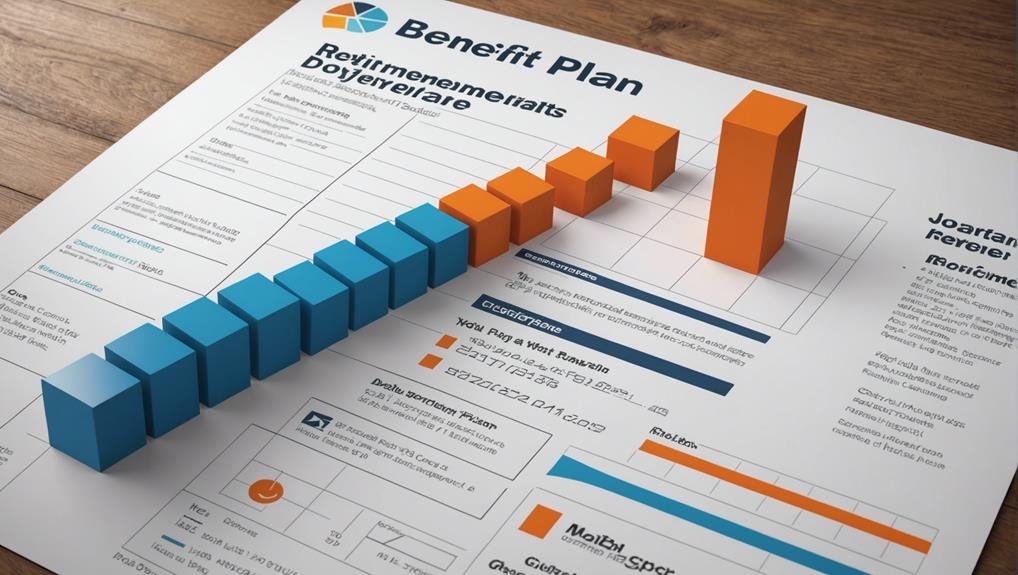What Is a Defined-Benefit Plan? Examples and How Payments Work
A defined-benefit plan is a retirement arrangement where pension benefits are determined by an employee's salary history and years of service. It offers a guaranteed payment through fixed monthly installments or a lump sum at retirement. Employees rely on calculations considering factors like age and service length. Employers make contributions towards funding these plans to guarantee financial stability. Payout options include choosing between monthly payments or lump sums, each with different tax implications. Retirement age greatly affects benefits, with early retirement potentially reducing total benefits. Understanding these aspects is important for informed retirement planning.
Key Takeaways
- Defined-benefit plans base retirement benefits on service length and salary history.
- Benefits are calculated using a formula considering age, service, and salary.
- Employers contribute to fund employees' retirement benefits.
- Payout options include monthly payments or lump sums.
- Retirement age affects benefits, impacting monthly payments and total amount received.
Defined-Benefit Plan Basics
Exploring the fundamental principles of defined-benefit plans provides a thorough understanding of these employer-sponsored retirement vehicles. These plans are intricately tied to employees' length of service and salary history. The benefit formula used in defined-benefit plans calculates retirement benefits based on these key factors, ensuring that employees with longer service periods and higher salaries receive higher benefits.
Retirement eligibility for these plans often requires a specific duration of work with the employer, typically measured in years of service. Meeting this requirement is essential for employees to qualify for the benefits provided by the plan. Understanding the benefit formula and retirement eligibility criteria is vital for employees planning their retirement and relying on these fixed monthly payments or lump-sum benefits.
Calculation of Benefit Payments
The calculation of benefit payments in defined-benefit plans is a structured process that determines the retirement benefits employees will receive based on specific factors such as length of service, age, and salary history. The benefit formula used in these calculations typically considers these variables to guarantee a fair and accurate assessment of the pension amount owed to the employee. Payment frequency in defined-benefit plans can vary, with common options being monthly payments or a lump-sum distribution. The table below illustrates how benefit payments are calculated in defined-benefit plans:
| Factors Considered | Description |
|---|---|
| Length of Service | Number of years the employee has worked for the company. |
| Age | The age of the employee at the time of retirement. |
| Salary History | Employee's earnings history, often based on the average salary over a specific period. |
| Benefit Amount | The calculated pension amount owed to the employee based on the benefit formula. |
Employer Contributions and Funding
Employer contributions and funding play an essential role in the sustainability and financial health of defined-benefit plans. These plans entail significant employer obligations, as they are responsible for funding the promised benefits to employees upon retirement.
Employer contributions are the primary funding sources for defined-benefit plans, with companies typically setting aside a percentage of each employee's salary to finance the future pension payments.
In cases where the plan's assets are insufficient to cover the benefits owed, employers may need to make additional cash contributions to fulfill their obligations. Understanding and effectively managing these funding aspects are important for ensuring the long-term viability and stability of defined-benefit plans.
Payout Options and Considerations
When considering defined-benefit plans, individuals must carefully evaluate the various payout options and associated considerations to make informed decisions regarding their retirement benefits. Payout options typically include monthly fixed payments or a lump sum. Choosing between an annuity or lump sum payment can impact the total benefit amount received.
An annuity provides a steady stream of income, while a lump sum offers the entire plan value at once. Tax implications should be considered when selecting a payout option, as different options may have varying tax consequences. Additionally, individuals should assess their investment strategies to make sure the chosen payout aligns with their financial goals and risk tolerance.
Making a well-thought-out decision regarding payout options is important in maximizing retirement benefits.
Impact of Retirement Age on Benefits
Optimizing retirement benefits involves understanding how the age at which an individual chooses to retire can greatly impact their defined-benefit plan payouts. The retirement age directly affects the amount that retirees receive from their defined-benefit plan.
Typically, retiring later can result in higher monthly payments due to a longer work history and increased service credits. However, retiring earlier than the plan's specified retirement age may lead to reduced benefits, as the plan assumes a longer payout period.
This decision can have a substantial effect on the individual's overall savings, with early retirement potentially diminishing the total amount received over the retirement period. Hence, carefully considering the impact of retirement age on benefits is important for maximizing savings and long-term financial security.
Conclusion
To sum up, the theory that Defined-Benefit Plans provide a secure financial future for employees holds true, as these employer-sponsored vehicles offer structured formulas for benefit calculations based on factors like length of service and salary history.
With various payout options available, such as lifetime annuities or lump-sum withdrawals, individuals must carefully consider their choices in order to maximize their retirement benefits.
Understanding the intricacies of Defined-Benefit Plans is essential for making informed decisions regarding financial security in retirement.







